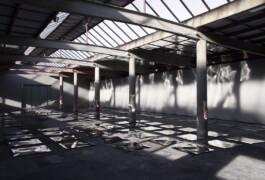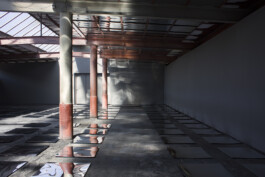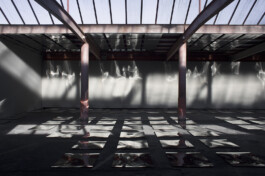Radiance, 2017
Polystyrol mirrors, wood, light
Site-specific installation, Kunsthalle Arbon 03.06 - 09.07.17
About Radiance and Control
Is the sunlight a wild animal to be tamed? Esther Mathis’ two-year-long research originated from the curious spaces that capture and filter light in museums. How do you control a natural phenomenon and constrain it for your purpose? Museum light ceilings attempt to create the “perfect” light, striking a balance between cancelling shadows yet preserving brilliance. Mathis went to thirteen museums to photograph and encounter various examples of these otherwise invisible spaces. Now Mathis sets the wild animal free from these cages of light again for her installation Radiance in the Kunsthalle Arbon. She gives the sun a room to play in and astonish us in its own captivating way. In this garden of reflections, composed of 246 rectangular acrylic mirror sheets on the floor and ceiling of the industrial hall, the sunlight roams free – not only unfiltered but multiplied.
The dominant location forces us to surrender to the space’s uncontrollable natural forces, the sunlight being only one of them. Mathis concedes that conquering them is an impossible task. The dust will never settle, the pollen will cover the mirror sheets, even the rain will enter through the porous ceiling and birds will build nests under it. Radiance is a hyper-site-specific work, because the space itself becomes the piece, irregularities and all. While it’s futile to gain full control of your surroundings, you can gently influence them. A valuable lesson to be learned.
The vivacious nature of the space hit me, after spending some time with[in] the installation. Sitting on one of the benches (around and inside the garden of mirror sheets) for a while, I noticed a peculiar sound — almost like rain falling onto the roof. But it’s sunny, no cloud in sight. Slight cracking sounds. The metal seems to expand and contract, reacting to the temperature and generating constant background noise. The sound comforts and disturbs me simultaneously. I feel like the whole structure around me is in flux and I am somehow becoming part of this larger assemblage. I also start to sweat and have difficulty concentrating. Like the bigger vessel around me, my body reacts to the sunlight and the heat it produces. Beyond the sweat, my boday is producing shade, changing the drawings on the wall as I move through the space and cast my own silhouette. A quiet duet between me and the reflections.
Mathis subtle intervention renders the building very much “alive” — the reflections on the wall seem to pulsate, pulling in and out of focus, similar in rhythm to a beating heart. Sometimes I am not sure if my eyes are creating an optical illusion or if the pulsation is really happening. I don’t try to find out. I bask in the perpetual becoming and unraveling of the drawings.
Despite the immense heat, which engulfs me as soon as I enter the space, I’m immediately hypnotised by the reflections on the wall. I don’t want to leave. The alchemic mixture of simplicity and complexity inspires a moment of awe in me. Mathis doesn’t completely let go of control with this installation — the mirror sheets are meticulously arranged to reflect the sunlight during the opening hours of the exhibition, based on the sun’s angles of incidence throughout the day. Still, the sun (constantly in motion) guides the drawing process in the end — not the artist or any other being. Beyond the fascination of the physical and natural phenomenon of light, Mathis’ work might speak to the personal wish to let go of constraints and filters, to show our full selves. Radiance lets the sunlight play and be, and in the process, tenderly urges us to feel comfortable doing so as well.
Robert Steinberger



Radiance, 2017
Polystyrol mirrors, wood, light
Site-specific installation, Kunsthalle Arbon 03.06 - 09.07.17
About Radiance and Control
Is the sunlight a wild animal to be tamed? Esther Mathis’ two-year-long research originated from the curious spaces that capture and filter light in museums. How do you control a natural phenomenon and constrain it for your purpose? Museum light ceilings attempt to create the “perfect” light, striking a balance between cancelling shadows yet preserving brilliance. Mathis went to thirteen museums to photograph and encounter various examples of these otherwise invisible spaces. Now Mathis sets the wild animal free from these cages of light again for her installation Radiance in the Kunsthalle Arbon. She gives the sun a room to play in and astonish us in its own captivating way. In this garden of reflections, composed of 246 rectangular acrylic mirror sheets on the floor and ceiling of the industrial hall, the sunlight roams free – not only unfiltered but multiplied.
The dominant location forces us to surrender to the space’s uncontrollable natural forces, the sunlight being only one of them. Mathis concedes that conquering them is an impossible task. The dust will never settle, the pollen will cover the mirror sheets, even the rain will enter through the porous ceiling and birds will build nests under it. Radiance is a hyper-site-specific work, because the space itself becomes the piece, irregularities and all. While it’s futile to gain full control of your surroundings, you can gently influence them. A valuable lesson to be learned.
The vivacious nature of the space hit me, after spending some time with[in] the installation. Sitting on one of the benches (around and inside the garden of mirror sheets) for a while, I noticed a peculiar sound — almost like rain falling onto the roof. But it’s sunny, no cloud in sight. Slight cracking sounds. The metal seems to expand and contract, reacting to the temperature and generating constant background noise. The sound comforts and disturbs me simultaneously. I feel like the whole structure around me is in flux and I am somehow becoming part of this larger assemblage. I also start to sweat and have difficulty concentrating. Like the bigger vessel around me, my body reacts to the sunlight and the heat it produces. Beyond the sweat, my boday is producing shade, changing the drawings on the wall as I move through the space and cast my own silhouette. A quiet duet between me and the reflections.
Mathis subtle intervention renders the building very much “alive” — the reflections on the wall seem to pulsate, pulling in and out of focus, similar in rhythm to a beating heart. Sometimes I am not sure if my eyes are creating an optical illusion or if the pulsation is really happening. I don’t try to find out. I bask in the perpetual becoming and unraveling of the drawings.
Despite the immense heat, which engulfs me as soon as I enter the space, I’m immediately hypnotised by the reflections on the wall. I don’t want to leave. The alchemic mixture of simplicity and complexity inspires a moment of awe in me. Mathis doesn’t completely let go of control with this installation — the mirror sheets are meticulously arranged to reflect the sunlight during the opening hours of the exhibition, based on the sun’s angles of incidence throughout the day. Still, the sun (constantly in motion) guides the drawing process in the end — not the artist or any other being. Beyond the fascination of the physical and natural phenomenon of light, Mathis’ work might speak to the personal wish to let go of constraints and filters, to show our full selves. Radiance lets the sunlight play and be, and in the process, tenderly urges us to feel comfortable doing so as well.
Robert Steinberger


